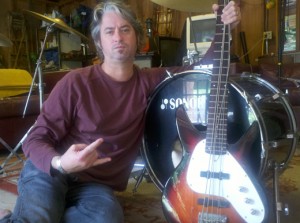All Mixed Up? Bass Management Techniques — by Jamey Staub
The latest in a series on raising your mix game, from the accomplished NYC mixer/producer Jamey Staub. Visit him early/often at http://www.jameystaub.com.
“The low end of the musical frequency spectrum provides the drive and soul of any musical piece.” – Jamey Staub, 2012
Whether you’re mixing Jazz, Hip Hop, R & B, Pop or Rock and Roll, there is one thing that you must understand: the Low-End Theory.
It is extremely important to get the frequencies below 500 Hz to work well together. If you don’t accomplish this, your mix will sound mushy and muddy with no punch.
There are quite a few tricks to achieve a desired result. Sometimes you need to reduce what’s going on with the low end, and sometimes you need to accentuate or add more to the bottom. In this article I’ll explain a few of the situations I have come across.
Boost, Cut and Combine: Hip Hop and R&B Drums
To know what to do, you as the mixer must consider the style of music that you’re working with. As most of you know, in Hip Hop and R&B there is a lot more low frequency information than in Jazz or Rock. So let’s start with Hip Hop and R&B.
The first thing I do when I get tracks to mix is pull up the faders and get a rough mix with no processing. That’s where you’ve got to determine how the writer/producer intended the bass and drums to work together — is the bass a super-low frequency sound that dominates frequencies from 120 Hz and below, or is there a booming 808 that needs that space?
You have to prioritize what instrument gets what frequency and fit them together like a puzzle. One way to do that is to find the frequency that is the strength and punch of the bass drum –either boost that frequency or cut around it to emphasize that strength. Then go to the bass and cut that frequency. The two will then be working together harmonically.
This also works with bass drum and snare. I tend to cut the bass drum around 200 Hz, and boost 200 Hz in the snare.
Often in Hip Hop and R&B there will be two or three bass drums intended to work together. On the latest Everlast record, Songs of the Ungrateful Living, this was the case on 80% of the songs (read the full SonicScoop feature on the mixing of the album here). One bass drum provided the low end, one provided the mid punch and one provided the attack.
I usually start with the lowest frequency item and tailor that around what the bass is doing. Next, I filter and EQ the mid so it doesn’t interfere with the low drum, and then I do the same with the attack drum. I then adjust the levels so they work together as one.
Rock Done Right with the EQ
In rock music where you have live drums there are several options.
We as mixers don’t always get optimally recorded tracks, and one option is to use drum replacement programs such as Drumagog and the new Massey DRT v2 plugin, which both work well. Personally I like to try to get the recorded sound to work before I resort to replacement.
From working in Hip Hop I learned to use the technique described earlier: I’ll copy the bass drum track to two other tracks and EQ them each differently – one for the low end, 50-80 Hz; one for the low mids, 90-140 Hz; and one for the attack – anywhere between 500 – and 3kHz, whatever works for the song.
I’ll either blend them separately, or buss them to an auxilliary track and blend them through a mutual EQ and compressor.
Enter Compression
So far I’ve only talked about using EQ to support the Low-End Theory, but compression is a factor as well.
I use compression in many different ways. The more compressed a bass drum is, the more “tight” it sounds and will be more punchy. However it will also sound smaller.
I often will split the bass drum track into two. The original track is EQ’d to emphasize the low-end, and the copied track is over-compressed to bring out the attack. I then blend the two accordingly.
Another use of compression I use to control bass drum and bass interactivity is to put a compressor on the bass. The next step is to buss the bass drum signal to the sidechain input of the compressor which is on the bass. This technique allows the bass drum to punch through the bass line — and gives you that Thump that makes you jump!
For an example of this technique in action, check out the track “Dreaming On” by the talented songwriter and performer Tom Anderson.
Addicted to Additives
A necessary part of this discussion is the use of additive techniques. There have been many times where the bass drum sample is simply too short in length and/or frequency to be adequate to support the Low-End Theory.
Two methods I employ are very effective to increase the bump in the trunk. First off, if the bass drum sample is short, you can
— Set up an additional track with a signal generator on the insert.
— Put a gate following the signal generator.
— Trigger the gate to open with a buss from the original bass drum track.
— Tune the signal generator to a sine wave any where between 40-120 Hz (whatever works with the key of the song) and extend each bass drum hit using the release on the gate.
Secondly, I also use subharmonic generators: A hardware piece I’ve used for a long time is a dbx 120 Subharmonic Generator. Simply bring the dbx up on a fader, feed the bass or bass drum to the input and adjust the level and frequency to taste. The software verion I use is the Waves Maxx Bass or Renasissance Bass to boost that low end.
With subharmonic generators, you have to be careful not to overdo it! So make sure you monitor at a loud volume and ensure that the woofers are not over-extending.
Analyze First – Apply Theory Later
The bottom line (no pun intended) in this discussion is to remember to analyze what type of song you’re mixing. Determine from the start which instrument will require attention and dominate the frequencies below 80 Hz, and build from there. If there are conflicting frequencies don’t be afraid to cut and boost to make the puzzle fit together.
Most of all have FUN.
Jamey Staub is a Producer/Mixer that loves to try anything that will make the song sound great. After twenty-five years of mixing he has learned the importance of upholding the low end theory.
Please note: When you buy products through links on this page, we may earn an affiliate commission.









Andy
June 26, 2012 at 4:51 pm (13 years ago)thanks for the heads up on the Massey drt. that is great stuff.
Jan
June 29, 2012 at 6:00 pm (13 years ago)Great info written in a clear and understandable way!
David Prouty
July 5, 2012 at 11:34 pm (13 years ago)This was actually useful. Clear and concise. Thanks